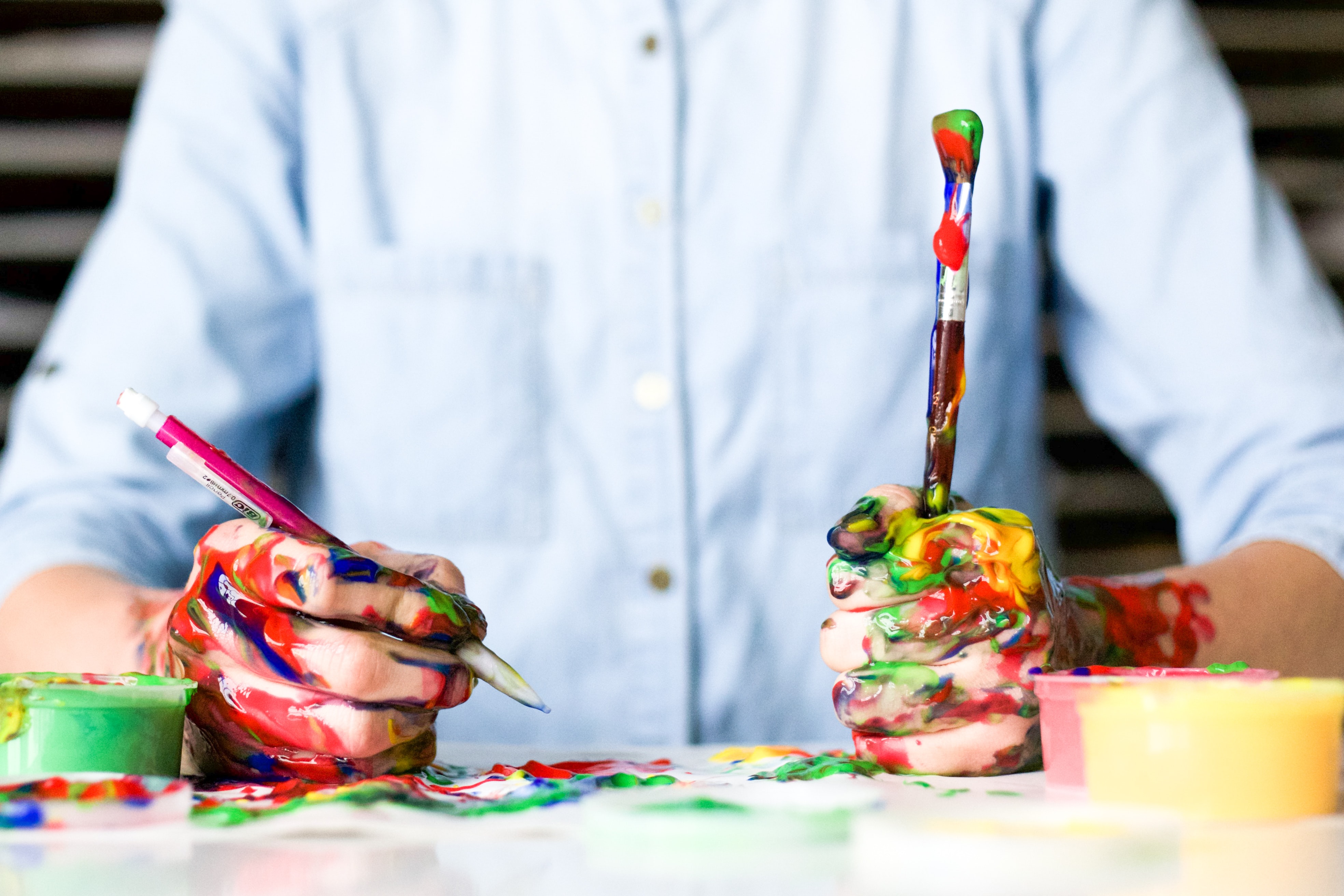
Hey, Every readers! This week, we’re excited to share an excerpt of a new book on creativity called Creative Doing, by writer and entrepreneur Herbert Lui. This book was written for entrepreneurs, freelancers, in-house creatives, hobbyists, and aspiring creators of all kinds—especially those who feel stifled by their day jobs, or otherwise blocked creatively. The premise of Herbert’s work is that creative thinking comes from creative doing—taking a little bit of action every day. So whether you have a project you’ve been meaning to pursue, you want to deepen your creative problem-solving, or unveil your creative purpose, the 75 prompts in this book are bound to help.
We’re sharing an introduction from Herbert and a few of these prompts in this exclusive excerpt—check out the book for more! If you like what you read, tweet at Herbert and learn more about his work.
Purpose from Process
Like many people aspiring to do creative work, I wasn’t born into a family of artists, or into unearned income that would enable me to pursue my art full-time. I didn’t participate in any talent shows, I’ve dealt with years of underestimating myself, and I wasn’t taught how to be creative in school. I wrote, and rewrote, this book not because I’m a creative genius revealing a secret, but because it was the book I needed to read.
I have been obsessed with the mystery of the creative process for over a decade. Successful artists had figured out how to do great creative work. Why couldn’t I?
I sought out every chance to find an answer. In the first half of the 2010s, I pored through academic literature, biographies, and memoirs. I interviewed prominent recording artists like Post Malone, and authors like Shane Parrish, on their processes. I seized every opportunity I could to ask people about their creative processes and for detailed examples of what they did to make their work. I immersed myself in a study of each individual’s creative process itself—the observable parts of ideation, creation, and release.
Creative work sounds simple enough (“Just make stuff!”), but it can feel painful when you don’t know how to make sense of it. For many years, I experienced a version of the creative block that might sound familiar: numbness. I wrote at a media company, started an editorial studio, and supported other people’s creative projects with marketing. I felt I had to suppress my true creative urges in order to make money. I tried my best to make it work.
Because I had so little time for the creative work I wanted to do—to write and express my own ideas—I became completely attached to the results I could attain. I wasn’t practicing, I was pushing. After months and years of this struggle, I realized that I was missing a piece of the puzzle: my own creative purpose.
Finding my creative purpose involved letting go of every impulse and habit that made me successful at my work projects, and shifting my focus away from results into the process. Process is about consistently making time and energy to practice every day, rather than intensely pursuing a creative project and then burning out, falling out of love with it, and becoming resentful. It’s about creating a lot of work that meets a standard I set for myself. There’s a chance you probably feel the same way I did; that throughout each day, the thought comes to you, “I’m meant to do something, and it’s not what’s in front of me right now.” What does it mean when you find yourself creatively blocked? What if that wave of inspiration never comes, and how are you supposed to know how long to wait? What if you can’t get started, or begin but don’t finish, or are always too busy with everything else?
Here’s the thing. Great ideas aren’t found, they’re made, through consistent creative practice. Creative thinking comes from creative doing. And that’s exactly what the following prompts, and this book, are for.
Know Your Stage
In 1926, London School of Economics co-founder Graham Wallas published The Art of Thought, in which he described a four-stage creative process. The first three stages were adapted from physicist Hermann von Helmholtz, and Wallas’s descriptions are in quotes:
Preparation: “the stage during which the problem was ‘investigated … in all directions’”—think about exercises, rituals, and routines that stimulate your mind.
Incubation: “not consciously thinking about the problem”—this is about consciously letting go of the problem and relaxing your mind. It might involve going for a walk in nature, or relaxing in a shower.
Illumination: “the appearance of the ‘happy idea’ together with the psychological events which immediately preceded and accompanied that appearance”—the eureka moment, where an answer comes to you, either quietly or striking like a bolt of lightning.
Verification: “the validity of the idea was tested, and the idea itself was reduced to exact form”—the phase where an illumination is tested through feedback or, in science, proofs and matching theories.
Whether it’s a 60-second speed writing exercise, or a song that takes 5,000 hours to perfect and record, every work goes through this linear process. You can look at any creative product through this lens. For example, virologist Jonas Salk spent his preparation phase cooped up in his windowless basement laboratory at Pittsburgh Municipal Hospital, working 16-hour days to figure out the polio vaccine. In exhaustion, Salk entered his incubation phase, retreating to the monastery at the Basilica of San Francesco d’Assisi in Italy, a magnificent structure permeated by natural light. That’s where the illumination happened. Of course, Salk attributed the discovery to his environment—but it’s important to consider that he was taking a break when the breakthrough happened. And lastly, the verification phase: in addition to testing two children at two Pittsburgh-area institutions, Salk injected himself and his family with the vaccine in his kitchen.
While most processes have start and end phases, in the creative process, a verification stage may also double as a preparation stage of a different project, which then starts a new cycle. Some people, upon getting new ideas for their project near the finish line, grow reluctant to draw their work to a close. That’s how the creative process can go on forever; it’s our job to draw it to a temporary close.
The value of the work is recognized when a version of the work is deemed finished. We must make the infinite finite. It is possible to update and iterate—many books have revised editions (like this one!), many albums get remastered and remixed—but the original work needs to be complete enough for people to watch, touch, listen to, taste, read, see, or experience in some other way. For example, you might find that getting the resources and support you need to make the best version of a book happens only after you complete and publish an article on the topic. That’s when the creative process can be seen as linear, for a single piece of work. A separate creative process can start over again once you decide to turn that article into a book.
Seeing this linear process is the key to understanding how to make each piece of creative work happen. The process can be straightforward and simple, like an assembly line. From this perspective, the goal of your creative process is to create a steady, predictable, and uninterrupted flow of creative work. Your creative process also should prevent you from getting blocked, fixated, or tormented by the excitement of new ideas or fixation on perfection.
Identify Your Bottleneck
In his 1984 business fable The Goal, Eliyahu M. Goldratt wrote about how any improvements or optimizations made to a single process are an illusion, unless they’re at the bottleneck. This is often the slowest step, or the weakest link. In their book Diaminds: Decoding the Mental Habits of Successful Thinkers, Mihnea Moldoveanu and Roger Martin describe this constraint as a “rate-limiting step,” and illustrate it with the example of the flexion hip joint, which gets in the way of even the fastest sprinter from being even faster.
This idea applies to your own creative process. It’s important to take a critical eye to your work and assess which part of the process is limiting you. If you’re not happy with your results, it’s easy to blame an absence of audiences or an unfavorable algorithm. But both of those are lagging indicators of high potential creative work and the promotional work that activates the potential.
Here’s a list of questions you can ask yourself to see which stage you’re getting stuck in the creative process, at the preparation, incubation, illumination, or verification stages:
- If it’s a struggle for you to come up with enough ideas, expand your preparation phase. Find more references and spend time studying them and distinguishing between the ones you like and don’t like, and why. (See Visit the Greats.)
- If you find you’re coming up with a lot of ideas, but none are resonating, expand your incubation phase. Give your brain more time to rest and relax. (See Make Idle Time.)
- If you find you’re missing breakthroughs, pay more attention. Write each breakthrough down whenever you feel your mind making a connection, whether it’s a small one or a big one. Don’t distinguish or edit what your mind is telling you. (See Write Down 10 Ideas.)
- If you find that you don’t have enough time and energy to make acceptable work, redefine what quality means to you at this point in your life. In all likelihood, you have to assess how much time, money, energy, and other resources you have to verify—edit, polish, refine, design—and lower the fidelity and scope you are shipping your ideas with. (See Complete Your Operation in Seconds.)
This last one is what I wrestle with the most. I tend to write pretty quickly, but I find it time consuming to come up with new, relevant ideas and pitch them to publications. This is the step I need to work on.
In order to continue supporting myself and strengthening my pitches, I’ll need to cultivate different sources, ones that spread news or share interesting perspectives faster. I need to focus my efforts into specific areas and use relevant events to speak to that area. I’m considering coming up with a weekly or even daily quota of article ideas that I pitch every day.
Since your situation is specific to you, I’ll suggest a few questions as starting points to get you to take a step back and look at your creative process:
- Dive deeper into these phases, especially if you find yourself getting stuck in one specific part. For example, you may find that your brain is out of practice with getting its unfiltered, unedited, incomplete, thoughts out there. You can then start designing your own exercises for this. (See Julia Cameron’s morning pages in Commit to a Size, and the journaling exercise in Stop Obsessing) Nobody else will read this. What’s on your mind? What are you feeling? What is clear and unclear to you?
- Think about thinking. Write down and listen to what your mind and body are telling you about a specific constraint. For example, is it expressing a fear of embarrassment? Or a skepticism that what you’re about to do is not worth doing? What emotion are you experiencing? What activities are you occupying yourself with instead of your creative work?
- Advise someone else in the same situation. If your friend or peer was approaching you with this problem, what observation would you make about where they were getting stuck? What would you say to them?
- Talk to a friend, or to yourself, about this question: Which part is the most painful part of the creative process for you? Why?
Through answering these questions, you can look into the section that you’ve identified, and pay attention the next time you go through the process. What is holding you up? What feels bad? What is your action, or reaction, that blocks you?
Relinquish Results
Throughout the years, we are conditioned to do things well and to constantly improve. If we’re not doing that, we’re led to believe we’re getting worse. If we regress, we are failures. These beliefs are all based on the flawed assumption that progress is linear.
At an extreme, this could lead us to chase perfection. If we can’t do something perfectly, we just won’t do it. Perfectionism creates an impossible standard for us to meet. This is just one of many reasons we start procrastinating and get blocked.
In his book Surely You’re Joking, Mr. Feynman!, Nobel Prize-winning physicist Richard Feynman recalls an art class when he was instructed to draw without looking at the paper. He was impressed with the results, noticing a “funny, semi-Picasso like strength” in his work. He knew that it would be impossible to draw well without looking at the paper, so he didn’t consciously try. He writes, “I had thought that ‘loosen up’ meant ‘make sloppy drawings,’ but it really meant to relax and not worry about how the drawing is going to come out.” The solution is to do something without caring about the results.
The immediate goal is for you to take a very small step closer to the thing you want to do. An earlier prompt in the book would suggest that you discover your form’s most essential element; now it’s time to build something with it. If you want to write a book, then write at least one sentence in a notebook today, building up to a daily writing practice. If you want to draw, sketch out a person or an object—don’t think too hard, just choose something in front of you and draw. If you want to make music, hum a melody into the voice memo in your phone and try to create it on an instrument or in your computer.
If you’re uncertain, then follow the first thing that pops into your head after 30 seconds. Or do the thing you think you want to do. Or do the thing you think your best friend thinks you want to do. Or write a list out and roll dice. Don’t make your goal to “finish a thing”; make it to “start with anything.” By design, the task should never impose on your schedule. It should be small enough that you can do it within a minute or two. That short time makes it difficult to do anything well, so hopefully you will put that possibility out of your mind and focus on the process. There will be a time and place to care about results—but it’s not while you do the work.
Roll the Dice
Letting go of control, and introducing chaos into an environment, is one of the keys to cultivating creativity. If you’re ever experiencing blockage or a sense of stuckness on a decision, try opening the door to chance in order to support your creative work.
In The Travels and Adventures of Serendipity, authors Robert K. Merton and Elinor Barber quote the late Professor Salvador Luria of the University of Illinois as praising “controlled sloppiness, which states that it often pays to do somewhat untidy experiments, provided one is aware of the element of untidiness.” In any case, the idea here is to trend toward chaos, entropy, and randomness in your work—a sense of controlled sloppiness.
For example, if you’re feeling stuck on what to write, you can take a chance with a dictionary or a random word generator. In literature, there is a constrained writing movement called Oulipo. Several of their techniques are set by constraints and involve chance. For example, the N+7 technique involves creating a new poem through taking an existing poem and replacing each noun with the seventh noun after it in the dictionary. In the 1920s artistic movement Dada, a common game to manufacture inspiration involved cutting up newspapers and pulling words and sentences out of a bag.
In the board game Letter Tycoon, each player starts their turn with a limited set of vowels and consonants, with the goal of spelling out the highest scoring words. You could replicate this game by picking eight letters and write as many words as you can with the set as possible. If you’re feeling ambitious, you can even compose a poem or write a sentence with the letters.
A popular improvisational comedy technique is the one word story, which requires two or more people. The goal is to tell a story by taking turns, each person adding one word at a time.
Similarly, in The Creative Habit, legendary choreographer and author Twyla Tharp shares an exercise where she throws a group of coins on a table. Based on how they land, she draws ideas from the arrangement, occasionally rearranging some of them to be in a more pleasing pattern.
Anytime you experience reluctance at leaving something up to chance, consider that Donald Glover developed his stage name, Childish Gambino, through a Wu-Tang Clan name generator. (He has succeeded perhaps in spite of the name, saying, “If I had known it was going to be something for real, I wouldn’t have used it.” The lesson I chose to take is there’s perfect vision only in hindsight, and you can make mistakes and still get to where you want to go!)
Chance plays a huge role in creativity and can be a useful generative constraint. If you want to make fewer decisions, enlist chance as an assistant. Whenever you need to make a decision, write out your options and let a coin toss, a dice roll, a results generator, or another person’s selection of multiple choice, to decide what you’ll do.
Do the Opposite
Whatever your routine is, flip it.
A friend once told me, “If you keep doing what you’ve done, you’ll keep getting what you’ve gotten.” I wrote this down, though I probably didn’t need to; it has continued boomeranging back into my brain throughout the years. Sometimes, in order to make breakthroughs or to disrupt our patterns, we need to flip our habits, routines, and rituals on their heads. Similar to rolling the dice, this is about opening the door to chaos to introduce new creative ideas.
Even if what you’re doing is getting you the results you want, it’s almost always worth trying something new in a small way (unless a process is in a critical stage of a project with high stakes—for example, you probably don’t want to change the way you fire up a kiln for a project you’d spent the past four months on). You’re creating an opportunity to get better results, or different ones. I discovered this saying through author Neal Pasricha’s book You Are Awesome: “Different is better than better.” Author Laura Huang writes a different version in her book Edge: “Different isn’t always better, but better is always different.”
“If you get so good at drawing with your right hand that you can even make a beautiful sketch with your eyes closed, you should immediately change to your left hand to avoid repeating yourself,” Marina Abramović quotes artist Krsto Hegedušić in her memoir, Walk Through Walls. In this case, you could try drawing for a few minutes with your eyes closed as Abramović suggests, and as Richard Feynman did. You could also try drawing with your non-dominant hand. If you like what you see, you could expand the time to an entire work session. The writer’s equivalent might be working on a piece of fiction if you’ve only ever written essays.
If you do your creative work in the morning, try doing it for an hour or two at night. One of my high school teachers had actually recommended waking up in the middle of the night to write. Interrupting sleep is certainly not pleasant, though the creative work you produce by shaking up your routine might be worth it.
If you start your creative process with meticulous outlines and sketches (as I do!), try doing the final version as soon as possible—even in a single work session. I find the time compression equal parts stimulating and exciting. Even though I end the session dissatisfied with the so-called final draft, I often look back and realize that it wasn’t as bad as I had thought. Conversely, if you’re used to completing your work in a day, take a week, or a month, to do it.
In addition to experimenting with time, you can also find an opposing space for one work session. If you usually work in large, open spaces, try finding one that’s extremely small (channeling your inner Jackson Pollock, who worked in a relatively modest studio, or Roald Dahl’s backyard hut). Conversely, if you usually work in a small space, try working in a big place, like the foyer of a public library or even outdoors.
Creativity means walking a tightrope between consistency and chaos. Switch up your routines so that you naturally add more novelty and vitality to your work.
Create a Quality Rubric
I’ve developed a definition of quality for all kinds of work I create. When assessing the quality of an article idea, for example, I look at timing, societal impact, counterintuition, action steps, and prior coverage. I discovered these attributes through noticing what ideas were accepted and rejected, through patterns I noticed in what I liked to read, and through papers I read. I refine the meaning of these words often, based on feedback from editors.
Criteria can be fluid; for me, they’re almost like rubrics, where I consider each of these factors, and I write down guiding questions to help me evaluate or test an idea. They also help me formulate the idea and position it.
For example, if I was looking at prior coverage, I would want to figure out how often this idea has been written about before, and in what ways. Do I have anything new to offer? Can I connect the big idea with a different small event, that’s more timely and relevant? Or is there an event that I can connect with a new idea?
I often write these questions down in second person, as if a writing coach were sending them to me. When I review each piece before I’ve decided that it’s done, I often also go through each of the criteria to make sure I can check it off.
As you develop your capabilities and perspective, you may find that list of questions getting longer. For example, in Let My People Go Surfing, Patagonia founder Yvon Chouinard writes of his own list of criteria to evaluate potential product ideas: Is it functional? Multifunctional? Is it durable? Does it fit our customer? Will people be able to repair it? Is the product and line simple? Is it an innovation or invention? Is it a global design? Is it easy to care for and clean? Does it have any added value? Is it authentic? Is it beautiful? Are we just chasing fashion? Are we designing for our core customer?
As a starting point, choose a creator in your field that you admire. Learn more about their process, through their own memoirs and interviews, or through other people analyzing their work. Be mindful of the standards that start jumping out at you.
You might also see whether the creatives you admire have written about their own quality criteria, as many have: The 20th century poet W.H. Auden put out his criteria for major poets, Robert Caro shows some of his thought process in his book Working, and Mary Robinette provides feedback for editing articles. If you want to emulate author, programmer, and entrepreneur Derek Sivers, he shows you how. The same with Y Combinator founder Paul Graham. You could also study any other writing you like, and learn how you can improve.
Practically speaking, I’ve found that the best time to strictly apply these standards of quality is in the verification stage of the creative process. I’m interested in completing the idea and making sure it’s polished enough for me to be satisfied with. However, I deliberately do not apply these standards to my generative work, like writing in a journal or notebook, if I’m just taking a note, or writing a blog post for fun. At those stages, I’m still exploring and discovering what I have to say on a topic. The idea is too fragile to go through this process. It still needs to be nurtured and developed.
Define Acceptable
Once you’ve defined what quality means to you, you can also define what is acceptable: the minimum bar for quality, a passable mark. Not complete, certainly not perfect, but acceptable for you to declare that it’s done.
When you choose to make something acceptable, rather than perfect, you reduce the expectations and ensuing pressure that could block your creativity. You complete your work, stay motivated, knowing another opportunity is just around the corner, which provides another chance to make something interesting.
Knowing what acceptable means to you helps when you’re deciding whether or not a creative work—or a version of it—is actually done. You might double check to see if all the parts of your work pass your standard. In my line of work (writing) that means I’ll edit my draft three times before it’s done. I check it for grammar, voice, tone, and flow. Similar to a factory line, though, it’s best to also add in other stages to check the work’s quality, so there aren’t any unpleasant surprises at the end.
This can literally be a series of sentences that enable you to communicate when something is done. For example, the GitHub team published the philosophies that drove their decision making in a document known as The Zen of GitHub, which includes this quality check: “It’s not fully shipped until it’s fast.” If you want to declare something as fully complete at GitHub, you need to make it fast, probably meeting a maximum of some predefined set of milliseconds.
As I heard from recording artist and amateur bodybuilder Kim Jong-kook, the workout doesn’t end at the gym: “You’re only done after you eat.” He said, “Some people don’t eat after working out to lose weight. You have to eat to build muscle. If you don’t eat, it’s just labor.” In other words, if you want to declare your workout acceptable, you need to be as mindful of how you nourish your body—with the quantities and types of macronutrients you need—as you are of what exercises you do.
For me, I check if my idea is acceptable as a pitch, before I even write it up. Pitches for my articles are acceptable when I’ve explained to myself and the reader why the idea is well timed, what it means to society, what people may misunderstand about it, what people can take away from this story and apply to their lives, and how few people have covered it before. If the pitch fails in some way (for example, if a lot of people have covered it before), the pitch does not pass, and it is not acceptable. I’m happy, as I didn’t need to spend time writing the entire story out only to realize this—I didn’t try to make it perfect before I made it acceptable.
Accept Imperfection
One powerful antidote to over-obsession is accepting that imperfection is the essence of nature itself. The Japanese philosophy of wabi sabi embodies this theme. Author Beth Kempton translates the two words in her book, Wabi Sabi: Japanese Wisdom for a Perfectly Imperfect Life: “Wabi is about finding beauty in simplicity, and a spiritual richness and serenity in detaching from the material world. Sabi is more concerned with the passage of time, with the way that all things grow and decay and how aging alters the visual nature of those things.”
With the understanding of the etymology, Kempton describes the concept the two words convey:
Wabi sabi is an intuitive response to beauty that reflects the true nature of life.
Wabi sabi is an acceptance and appreciation of the impermanent, imperfect, and incomplete nature of everything.
Wabi sabi is a recognition of the gifts of simple, slow, and natural living.
Wabi sabi is a state of the heart. It is a deep in-breath and a slow exhale. It is felt in a moment of real appreciation—a perfect moment in an imperfect world.
We must accept that each imperfection is not a failure; rather, in wabi sabi fashion, each one makes the piece perfectly imperfect. Otherwise, obsession becomes a prescription for failure. An expectation or obsession for quality does not necessarily always result in it.
If you liked these prompts, you can learn more about the full version of Creative Doing, available at Holloway (digital) and Amazon (print).
The Only Subscription
You Need to
Stay at the
Edge of AI
The essential toolkit for those shaping the future
"This might be the best value you
can get from an AI subscription."
- Jay S.
Join 100,000+ leaders, builders, and innovators

Email address
Already have an account? Sign in
What is included in a subscription?
Daily insights from AI pioneers + early access to powerful AI tools

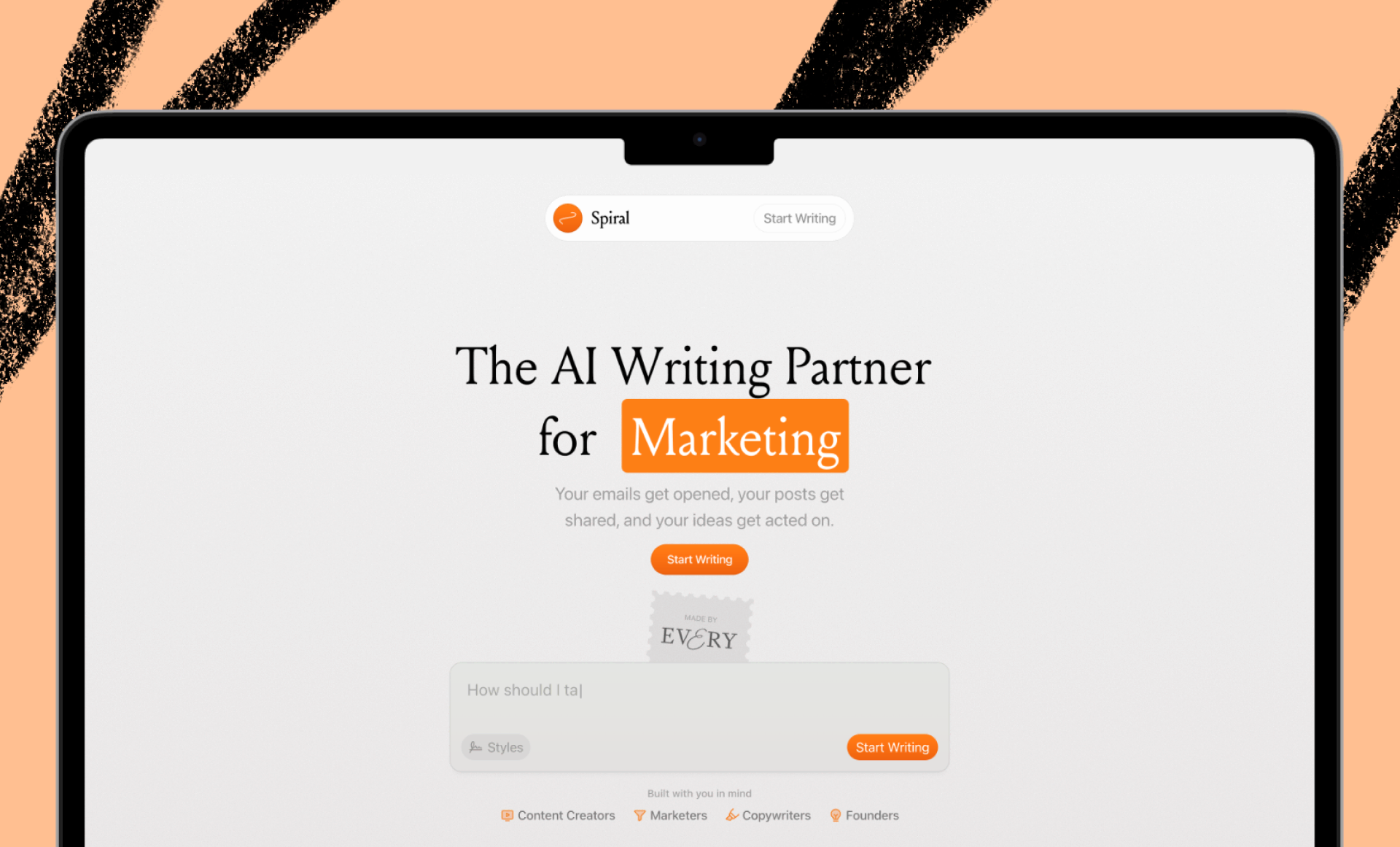
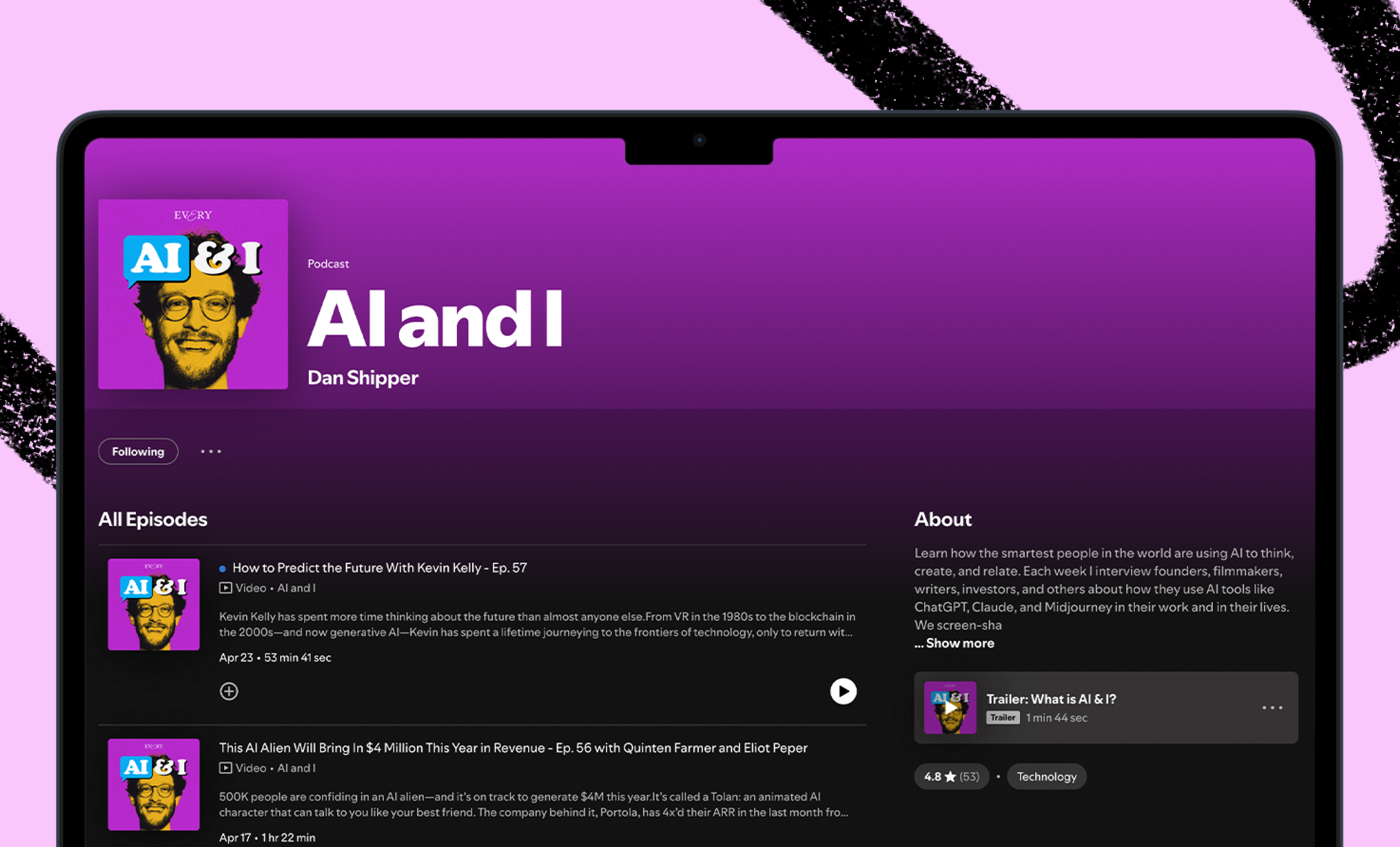
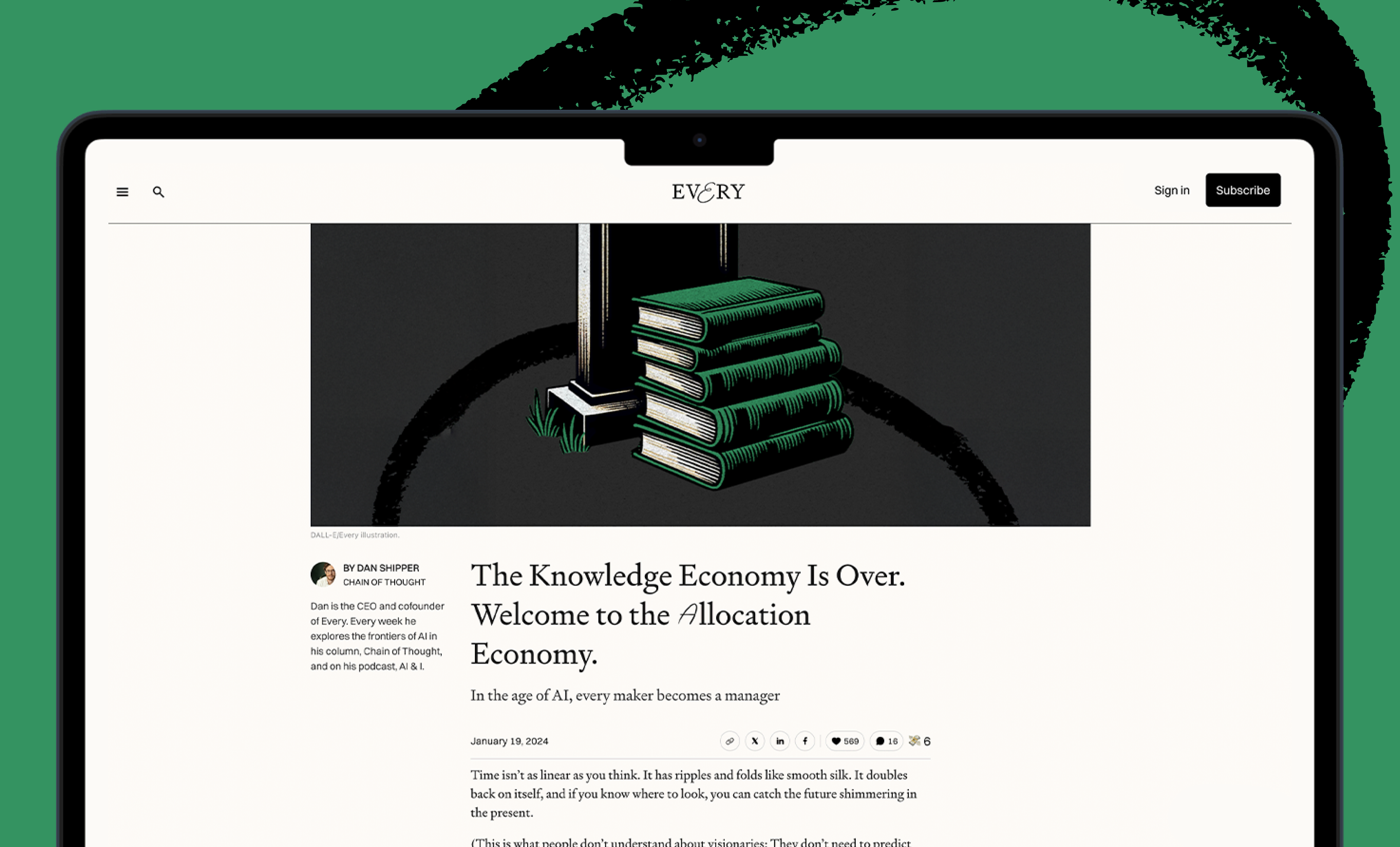

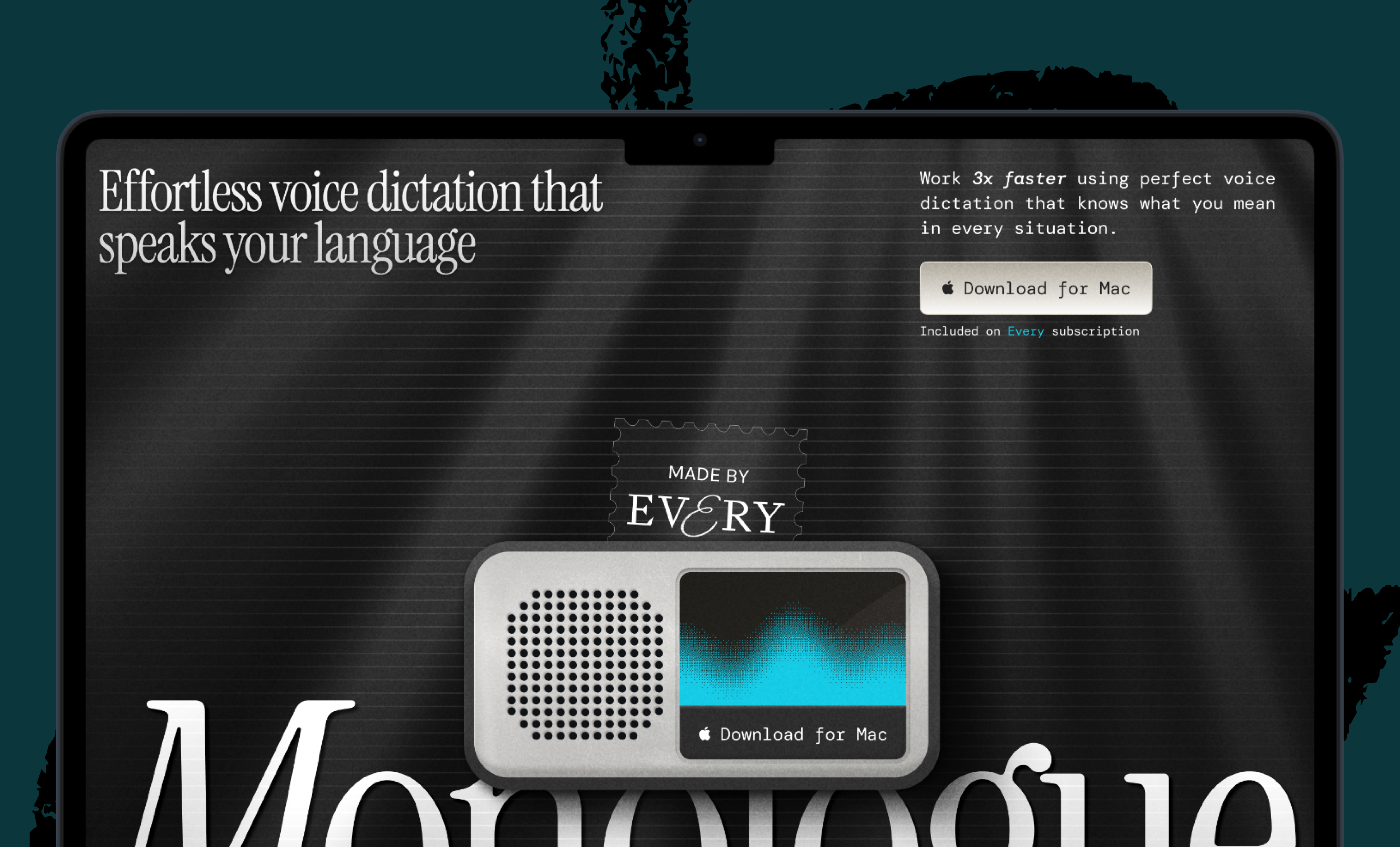
Comments
Don't have an account? Sign up!
"We must accept that each imperfection is not a failure; rather, in wabi sabi fashion, each one makes the piece perfectly imperfect."
I'll keep this in mind the next time I'm drafting a blog post. 🙌